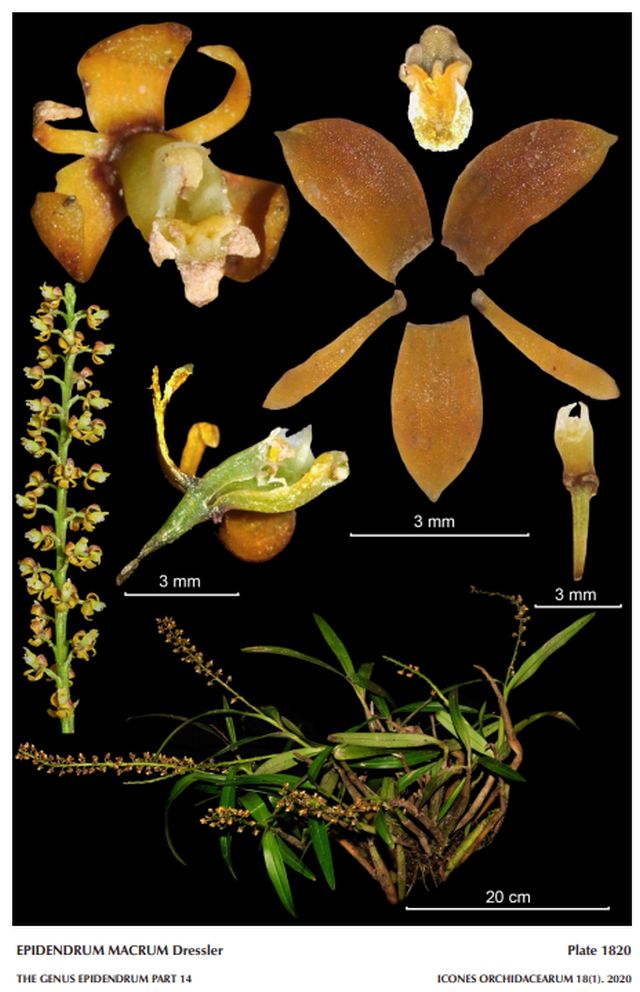

Epidendrum macrum Dressler 1967 GROUP Amblostoma SUBGROUP Amblostomioides
LCDP Photo by © E. Morón, B. Collantes & A. Cisneros and Icones Orchidacearum 18(1) plate 1820 2020
Photo by © Karl Siegler
Photo and plant grown by © Marni Turkel
Original Drawing by © Padre Pedro Ortiz Conserved at the Herbario de la Universidad Javeriana, Bogota Colombia








Common Name The Crassula Like Epidendrum [A Succulent Plant]
Flower Size .4" [1 cm]
Found in southern Colombia, Ecuador and Peru on the eastern slopes and valleys of the Andes from southern Colombia to central Peru in wet montane forests at elevations of 1000 to 2500 meters as a miniature to small sized, cool to cold growing epiphyte with an erect, straight, somewhat thickened, forming thin, fusiform pseudobulbs, apically 1/3 leafy stem carrying 2 to 5, ovate, narrowly lanceolate-elliptic, grass-like, somewhat spreading, slightly arched, acute, obliquely bilobed apically leaves that blooms in the summer on a terminal, stiffly erect to arched, peduncle .32 to .68" [.8 to 1.7 cm] long, terete, thin, unornamented, rachis, .92 to 8.52" [2.3 to 21.3 cm] long, terete, scarcely minutely dactylo-verrucated, racemose, successively several, 19 to 75 flowered inflorescence with minute floral bracts, pubescent ovaries and non-resupinate, long lasting, very fragrant, cupped flowers that eventually are all open at once.
Epidendrum macrum belongs to the GROUP Amblostoma SUBGROUP Amblostomioides, which is characterized by the sympodial, caespitose habit, the thinly fusiform stems with sub-coriaceous leaves distributed along the apical half of the stems, the ovary and the sepals usually dorsally pubescent, and the lip 3-lobed. The species is recognized by the erect, racemose inflorescence, helicoid and densely flowered, flowers non-resupinate, ochre yellow, the apex of the column and lip white, ovary and rachis pubescent, sepals 1.36" x .6" to .08" [3.4 x 1.5 to 2.0 mm], elliptic, petals .12 to .16 x .24 to .38" [3.0 to 3.5 x 0.6 to 0.95 mm], oblong, oblanceolate, margins of the clinandrium-hood and wings of the column dentate, and the lateral lobes of the lip quadrate, oblique with the posterior margin involute. It is similar to Epidendrum appendiculatum T.Hashim. from central Peru, but that species has an erect, racemose to paniculate inflorescence, the ovary is very thin along the basal 2/3 and smooth, warted only in the apically thickened 1/3, the lateral lobes of the lip are wider, dolabriform and erect, the mid-lobe is triangular, apically rounded, and the callus is a very prominent quadrate platform which completely covers the basal half of the mid-lobe. Epidendrum holochilum (Schltr.) Mansf. ex Hágsater is vegetatively similar with a racemose to paniculate, erect inflorescence, small, pale yellow, resupinate flowers, sepals .083" to .12" x .048" [2.75to3.0 x 1.2 mm], and a cordiform, entire lip with 3 parallel calli continued into 3 low ribs." Hagsater & Santiago 2020 "Superficially the plant looks like E opiranthizon but it has a racemose inflorescence carrying small, non-resupinate flowers opening from the apex of the raceme backward, The lip entire, hexagonal-subrhombic; bicallose, the calli prominent, laminar, fleshy, elongate, reaching the middle of the lip, with a prominent, intermediate keel, as long as the calli and rounded at the end. Epidendrum roncanum Dodson & R Vásquez has a paniculate inflorescence and the 3-lobed lip has a long, spatulate midlobe. Epidendrum chiguindense Hágsater & Dodson also produces the flowers from the apex of the inflorescence backward, but has short, laterally compressed stems, thick, coriaceous leaves, a long, arching, nutant, rat-tail inflorescence with a long, narrow spathaceous bract at the base, numerous, green, successive flowers, and a triangular, cordate lip with a prominent, fleshy, striated, "V" shaped callus." Adapted from E opiranthizon Icones Plate 863 Hagsater etal 2006
Synonyms Amblostoma gracile Garay 1953; Amblostoma gracile var. robustum C.Schweinf. 1955
References W3 Tropicos, Kew Monocot list , IPNI ; Orchids of Peru Vol 2 Schweinfurth 1959 as Amblostoma gracile var robustum drawing fide; Die Orchideen 3 Auflage Bd 1 Sonderabdruck aus Schlechter Lieferung 8 449 - 512 Brieger, Maatsch and Senghas 1976 as Amblostoma gracilis; Icones Orchidacearum 2 Plate 165 Hagsater & Dodson 1993 see recognition section; Icones Orchidacearum Peruviarum Plate 465 Bennett & Christenson 1998 drawing ok; Icones Orchidacearum Vol 8 Plate 863 Hagsater & Sanchez 2006 see recognition section; AOS Bulletin Vol 77 no 11 2008 photo fide; AOS Bulletin Vol 85 #1 2016 photo ok; Orquideas, Tesoro de Colombia Vol 2 Ortiz & Uribe 2017 drawing not = E mancum?; Icones Orchidacearum 18(1) plate 1820 Hagsater & Santiago 2020 Photos fide
--------------------------------------------------------------------------------------------------------------------------
-------------------------------------------------------------------------------------------------------------------------